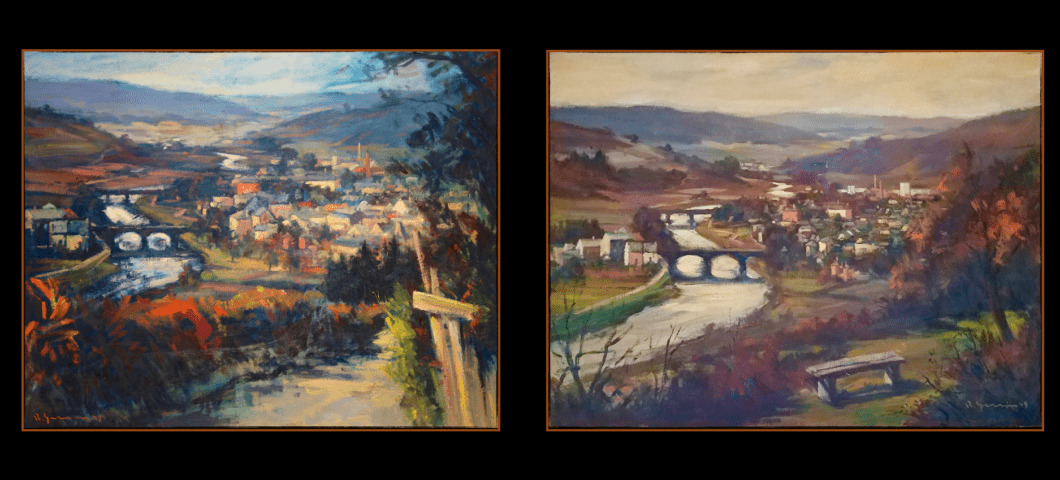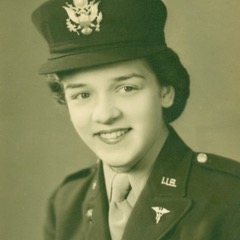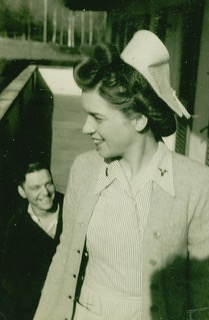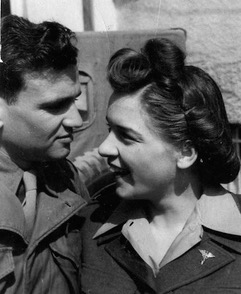On March 12, 2020, Carine Welter, Director of the Museum of Histories Diekirch, Luxembourg, contacted the Mount Vernon Historic Preservation Commission’s website with a request for any documentation of Mount Vernon’s involvement in Operation Democracy and a photo of the original oil painting. The panoramic view of Diekirch by artist Roger Gerson was accepted on behalf of the MVHPC in 2019, when the Mount Vernon High School no longer had room to display the artwork. The painting hangs in the Visitor Center. We had success in researching Operation Democracy using the online Archives of The Mount Vernon Hawkeye-Record and Lisbon Herald newspapers.
Carine and I commiserated about the Pandemic keeping us from entering our respective places, museum & archives, to make sure our artifacts and documents were safe. I told her that my father Leoral C. Evans and his friend Harold Beach both of Mount Vernon fought in the Battle of the Bulge. Harold was killed during the battle and is buried in the Ardennes American Cemetery. Leoral C. Evans, returned home safely on February 16, 1945, his 35th birthday.
On December 13, 2020 I received an email from Carine Welter that the exhibition was open to the public.
“So, I just want to let you know, that today we have the opening of our exhibition about the reconstruction (but very quietly due to Corona-restrictions) and Paul Bonert published an article about Mount Vernon at this occasion.
Here is the link: https://dikrech.csv.lu/2020/12/svq_167-twin-picts-en/
Articles from The Mount Vernon Hawkeye-Record and Lisbon Herald newspapers are cited 24 times with links to VisitMVL.com including photos. The October 28, 1948 article lists Mrs. Robert V. Smith as the chair, temporary secretary Mrs. Charles D. Starr (A.A.U.W.), publicity chairman is Miron A. Morrill (journalism teacher at Cornell) and other members of the group are Mrs. C.H. Ford (Women’s Industrial Society), Carrie Oates (Sorosis), Virginia Anderson (Kappa Psi Omega) and Larry Ringer (sixth grade student. It’s exciting that Diekirch, Luxembourg is celebrating the generosity of Mount Vernon’s residents.
The following is the original email received on March 12, 2020:
Dear Madam, dear Sir,
I hereby contact you with the following concern: In June 2020 we – the Museum of Histories Diekirch in collaboration with the National Museum of Military History (Diekirch) – plan an exhibition about the reconstruction years from 1945-1960 in Luxembourg.
The two museums will show each a part of the history: The national reconstruction will be on display in the National Museum of Military History and the local reconstruction will be shown in our museum, knowing that Diekirch was strongly hit during the Battle of the Bulge and its population suffered from great losses in many ways.
Research has proven that for Diekirch not much has been looked at for this period of history yet, so that we are still quite at the beginning of our discoveries. None the less, sources reveal that, on behalf of an initiative from the “Fiends of Luxembourg”, Mount Vernon adopted Diekirch in early 1949 and gave intense help with textiles, medicines, and other items (like a movie projector with a canvas).
Therefore, I would like to ask, if you maybe have any records about activities for Diekirch during that time? I would be very grateful for any help!
Sincerely, yours Carine Welter Director Musee d’Histoires Diekirch 13, rue du Cure L-9217 Diekirch Tel.: 352 80 87 901
Carine Welter
[email protected]
The following is the painting’s description that accompanied it to Mount Vernon:
The painting represents a panoramic view of the town of Dierkirch, Luxembourg. It was presented to the town of Mount Vernon in 1950 to give thanks for the help their town received from the citizens of Mount Vernon after it was destroyed by war. It likely would have ceased to exist without aid.
Adopted by Mount Vernon (and other U.S. towns) during Operation Democracy, Inc., townspeople rallied to help the war-torn town. This project was led by the Diekirch-Mount Vernon committee and chair Mrs. Robert Smith.
The town of Diekirch was occupied by enemy forces during WWII, and was in the direct line of fire, bombardment, and shellings. The Battle of the Bulge to these people was more than a vague war term. The population was evicted, going on foot, they could not even use roads because they were needed by troops. In the bitter cold of December, the women and children walked the railroad tracks, 50 miles to the south carrying just what they could. When they returned, they found much of the town either gone or damaged. The citizens of Diekirch lacked even the basics. Mount Vernon gathered and sent 32 cartons of clothing, toys, toiletries, letters, books and more. In addition, funds sent were used to purchase books and supplies for the grade school.
Mayor Alphonse Greisch wrote:
To mark our grateful acknowledgement for your generous adoption and the help you have given to us, I send a painting, done by an artist of Diekirch, Roger Gerson, represents a big part of our town, and I hope you like it.
Dorothy Johnson Humphries was an Army Nurse assigned to the Battle of the Bulge
Dorothy Johnson (Dot or Johnny) Johnson Humphries was one of 500 nurses the army recruited for the Battle of the Bulge. Marcia Humphries Driscoll, Dorothy’s daughter, gave permission to publish this portion of Dorothy’s diary.
1941: In September I entered Michael Reese Hospital School of Nursing. My Mother enabled me to attend this school. She had the foresight to take out an Insurance Policy, which was enough to pay my way to attend Michael Reese.
At Michael Reese Hospital, the director of the school told us to look to the left of you and to right of you. One of you will graduate. I decided at that moment I would be the one to graduate. I took the challenge and ran with it.
1944: Mom and Dad were able to come to Chicago to attend my graduation at Reese. This pleased me so very much. As the years went by, it meant even more to me that Mom and Dad were at my graduation.
I graduated from Nursing School and became Head Nurse of 4th & 5th floors of Sarah Morris, the pediatric hospital.
I was very pleased and I confess, “To the sin of pride, that I was told on Graduation, I would be able to work in the delivery room, the operating room or the children’s hospital. I chose the Children’s Hospital. My dream of caring for sick children is fulfilled at last, but this dream was not to last! Upon graduation the school expected the students to stay on for an additional six months.
In December, WWII was in progress and not going well for the allied forces. It looked as if we might be losing the war. The Germans had broken thru our lines in Belgium, creating what was named “The Bulge”. The situation was critical. Our causalities were very heavy and nurses were badly needed. The Army requisitioned 500 nurses immediately to take care of the causalities. I became one of those nurses.
1945: In March I along with 12 other nurses from Michael Reese Hospital in Chicago, were inducted into the Army. From Chicago we boarded a train for Camp McCoy, Wisconsin. We arrived at Camp McCoy in the wee hours of the morning by train. The first thing we did was sign a stack of papers. Including a will, power of attorney (in case we didn’t come home of course!). Finally, we were taken to a barracks with about 20 canvas cots on each side of the room. We made our beds and finally settled down to sleep-at long last. But, before long I was awakened by loud laughter. I was told later, I had talked in my sleep; saying, “I don’t care what you say! I am not going to sign any more papers!!” my friend Gilda De Luca was at the other end of the room, also sound asleep… she answered” that’s OK Johnny you don’t have too!”
At Camp McCoy, we had physicals, received shots and tests for all diseases. We learned to march and to perform commands-ie: Right face & left face, about face, forward march, to the rear march (only the way the sergeant said it, it sounds more like “Harch”. Sounds easy but we took quite a while to get the hang of it. We also learned how to salute, and when to salute and whom to salute; ie: always the General’s car whether he was in it or not.
We learned how to abandon ship by climbing down a rope ladder from a wall that was as high as the ship was above the water. We also, had to go on a 2-mile march. Next, we had to go into a very small enclosed building and remove our gas mask. We then had to repeat our name, rank and serial number (N-79-48-54). It seemed they wanted us to know what tear gas and the other gases were like. Well, believe me it is not pleasant. Your eyes burn like fire and you feel as if you are going to choke to death.
I distinctly remember we were rushed thru everything, being told “you are a hot shipment!” because we were part of the 500 nurses the army had requisitioned.
In April, we arrive at Indian Town Gap, PA. This was a staging area where we were prepared and equipped for deployment overseas. Here we went thru the whole routine again. We also went on a 4-hour march. No fun, many blisters. Ouch, ouch and ouch again! We are issued combat clothes- including a pair of 4 buckle artic overshoes.
We board a very old coal powered, smoky train to an unknown destination. It turned out to be Camp Kilmer, New Jersey. This was our Port of Embarkation. We are hearing rumors that the Germans are ready to surrender-but there is nothing official. One of the nurses started yelling, We’re in Jersey”, we’re in Jersey”. And we were. We all know by now that we are part of a group of 500 nurses who were requisitioned in December 1944 to care for causalities sustained in the Battle of the Bulge in Belgium near Bastogne. Of course, we were too late. Nonetheless we did continue on, as we still had wounded soldiers in Germany in hospitals, who needed our care.
A few days later, we went thru New York on a bus and taken to the waterfront. As always, we were not told what was to come next. There was a large dock and a huge ship on the water, this turned out to be “The Isle de France”. As we marched towards the ship and arrived at the gangplank the band was playing “A pretty Girl is Like a Melody”. Very nice, but we were wearing a 18# steel helmet, carrying a big suitcase, loaded with enough clothes and supplies to last for 3 months, a back pack, a purse jammed full, a gas mask and 2 pairs of 4 buckle artic overshoes. We didn’t feel very pretty. But on we went. Just behind me were twin sisters (the Ryan twins) one of them was crying, “I don’t want to go overseas, I want to go home and marry Mac!”.
Our ship “The Isle de France” was one of three luxury liners at the time. However, it was stripped of all its grandeur. The next shock was we thought the ship was French, the crew was English. Well, the food was poor. Normally one felt a little “ishy”. When we went to eat one of the stewards told me “you won’t want to eat, but you have to eat because, if you don’t your stomach is empty and you will get sick. I always adopt a pet on the trip and take care of her. You are my “pet” this trip.” I didn’t get sick.
In May, the 500 nurses arrived in Gurock, Scotland. We were placed on a train going south and eventually reached London.
(The detailed notes from Dot ends……here is a list of the hospitals she worked:)
- 102nd General Hospital in Lavington, England
- 82nd General Hospital, Aix-en Provence, France
- 58th Field Hospital Badweisse, Germany (met Dewey serving in the air corps)
- 57th Field Hospital Goppingen, Germany
A final note from Dot:
1946: In June, I was in LeHarve, France, waiting for transportation home aboard The Algonquin. We boarded very late at night-no wonder! This so-called ship sailed from New York to Miami and back in peacetime- a very small ship!
Not in Dot’s notes, but I remember her telling me about the 58th field hospital in Germany. Patients were in several different buildings and she would have to walk between the buildings during her night shift. One of the soldiers (a patient) would always accompany her when going to another building because German soldiers would cut the communication lines between the buildings every night and they didn’t want her to walk alone.




